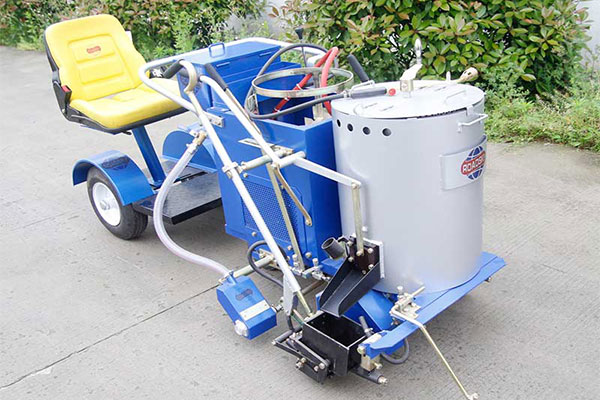
In modern infrastructure, road markings play a vital role in guiding drivers, cyclists, and pedestrians.
These markings ensure safety by providing clear instructions, lane divisions, pedestrian crossings, and other essential information.
To make these markings efficient and durable, road marking machines are used. But what exactly is a road marking machine, and how does it contribute to the development of safe roads?
In this article, we will explore what a road marking machine is, its various types, how it works, and its importance in today’s road systems.
What Is a Road Marking Machine?
A road marking machine is a specialized piece of equipment designed to apply lines, symbols, and signs on roads, parking lots, and other surfaces. These machines are essential for painting the clear, accurate, and durable markings we rely on when navigating streets and highways.
They use different methods to apply marking materials, such as thermoplastic, cold paint, or preformed tape, depending on the required durability, road conditions, and regulations.
Types of Road Marking Machines
Road marking machines come in different types depending on their specific function, the marking material used, and the scale of the job. Here are some of the most common types of road marking machines:
1. Manual Road Marking Machines
Manual road marking machines are designed for smaller projects and require an operator to push the machine along the surface to be marked.
These are ideal for parking lots, small roads, or pedestrian zones where high precision and flexibility are required. Manual machines are generally lightweight, easy to maneuver, and suitable for smaller-scale jobs.
2. Automatic Road Marking Machines
Automatic road marking machines are more advanced and are typically used for larger-scale projects, such as highways or long roads.
These machines are either self-propelled or vehicle-mounted and are controlled by an operator from the vehicle. They are capable of covering long distances and provide excellent precision at high speeds, making them ideal for large road projects.
3. Thermoplastic Road Marking Machines
Thermoplastic road marking machines are specifically designed to apply thermoplastic material. Thermoplastic is a popular choice for road markings because it is durable, highly reflective, and long-lasting.
These machines heat the thermoplastic material to high temperatures and then apply it to the road surface, where it hardens into a durable marking. Thermoplastic road marking machines are commonly used for highways, intersections, and pedestrian crossings.
4. Cold Paint Road Marking Machines
Cold paint road marking machines use a spray system to apply liquid paint directly to the road surface. These machines are versatile and can be used for a wide range of applications, from temporary road markings to permanent ones.
They are often used for projects where a quick application is needed or when thermoplastic markings are not required.
5. Line Marking Machines
Line marking machines specialize in applying straight lines on roads, parking lots, and sports fields. These machines can be manual or automatic and use either thermoplastic or cold paint, depending on the project requirements.
Line marking machines are known for their precision and are ideal for creating lane dividers, pedestrian crossings, and boundary lines.
How Do Road Marking Machines Work?
A road marking machine works by applying the chosen marking material (such as thermoplastic or cold paint) in precise patterns. The process involves several key components, including:
- Material Reservoir: This is where the marking material is stored. In thermoplastic machines, the material is heated to a high temperature, while cold paint machines use a pressurized system to spray the paint.
- Application System: The machine uses a system of nozzles or extruders to apply the material to the road surface in the desired pattern. This can include lines, arrows, or symbols.
- Guiding System: For straight and accurate lines, most road marking machines are equipped with guiding systems such as lasers, GPS, or manual guides to ensure that the markings are applied in the correct position.
- Reflective Beads: In many cases, reflective beads are embedded into the markings to enhance visibility at night. These beads are added while the material is still wet or hot, ensuring they bond properly with the marking material.
The Importance of Road Marking Machines in Road Safety
Road marking machines are critical to ensuring that roads are clearly marked, safe, and easy to navigate.
Without proper markings, drivers would have difficulty staying within lanes, identifying pedestrian crossings, or following other essential road instructions. Here’s why road marking machines are so important:
1. Increased Road Safety
Clear and visible road markings reduce accidents by guiding drivers and pedestrians. Whether it’s lane dividers, stop lines, or crosswalks, markings are crucial for maintaining order on busy roads and preventing confusion.
2. Time and Cost Efficiency
Using road marking machines for large-scale projects is much faster and more efficient than manual methods.
Automatic machines can cover long distances quickly, reducing labor costs and downtime. This efficiency is especially important for highways and busy city roads, where road closures need to be minimized.
3. Durability and Precision
Machines ensure that markings are applied precisely and consistently. Manual painting often results in uneven lines, but road marking machines guarantee straight, durable, and accurate markings that can last for years, even under heavy traffic.
4. Versatility
Different road marking machines allow for a wide variety of marking types, from simple lines to complex symbols. Whether it’s a school zone, a highway, or a sports field, these machines can handle the diverse needs of marking professionals.
Factors to Consider When Choosing a Road Marking Machine
Choosing the right road marking machine depends on several factors, including the scale of your project, the type of marking material, and the conditions of the surface. Here are a few things to consider when selecting a road marking machine:
- Type of Material: Thermoplastic is ideal for high-traffic areas, while cold paint is better for smaller or temporary projects.
- Project Size: For large highways or long-distance markings, an automatic road marking machine is more efficient. For small parking lots or pedestrian areas, a manual machine may suffice.
- Precision Needs: If the project requires highly precise markings, a machine with advanced guiding systems (such as GPS or lasers) will be necessary.
- Surface Type: Some machines are better suited to different surface types, such as asphalt, concrete, or dirt roads. Ensure that the machine you choose is compatible with the surface you’re working on.
Conclusion
Road marking machines play a crucial role in maintaining safe and organized roads. With various types available, from manual machines for small projects to automatic thermoplastic machines for highways, there’s a solution for every road marking need.
These machines increase efficiency, ensure precision, and provide durable markings that contribute to safer roads for everyone.




